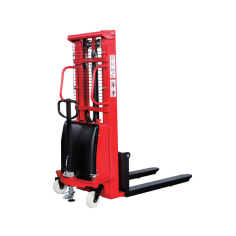
In today's fast-paced industrial world, effective material handling is a key factor in ensuring smooth operations and maximizing productivity. The manual stacker series(https://www.shanyelift.com/products/manual-stacker-series/) has emerged as a reliable and versatile solution for lifting and transporting heavy loads. With its innovative features and wide range of applications, this series has become an essential tool in warehouses, factories, and various industries. This article will delve into the product features and explore the diverse applications of the manual stacker series.
Product Features
Robust Construction: The manual stacker series is built with high-quality materials to ensure durability and long-term reliability. Its sturdy frame and reinforced components enable it to handle heavy loads with ease. The stacker is designed for heavy-duty use, making it suitable for demanding industrial environments. Manual Operation: As the name suggests, the key feature of the manual stacker is its manual operation. With a lever or handle, operators can effortlessly lift and lower loads. This simplicity makes it easy to operate and eliminates the need for complex training or reliance on external power sources. Ergonomic Design: The manual stacker series focuses on operator comfort and safety. Ergonomic features such as adjustable handles, easy-grip controls, and cushioned handles reduce strain and fatigue during operation. Additionally, safety features like non-slip platforms and braking systems enhance operator confidence and prevent accidents.
Lift Height and Capacity: The manual stacker series offers various lift heights and load capacities to cater to different requirements. These stackers can efficiently lift loads to significant heights, providing access to overhead storage or shelving areas. The capacity to handle heavy loads makes them ideal for lifting items like palletized goods or equipment. Compact and Maneuverable: Designed with compact dimensions, the manual stacker series excels in maneuverability, even in tight spaces. Its small turning radius allows operators to navigate narrow aisles and congested areas with ease. This feature is particularly beneficial in warehouse settings with limited space for material handling equipment.
Applications
Warehousing and Logistics: Manual stackers are widely used in warehousing and logistics operations. They efficiently handle palletized goods, allowing operators to stack, transport, and store loads with precision. Their compact size enables easy maneuvering in narrow aisles and confined spaces, optimizing storage capacity. Retail and Distribution: The manual stacker series is also employed in the retail and distribution sector. It aids in the organization and movement of goods within a store or distribution center. Operators can use the stacker to load and unload delivery trucks, stack products on shelves, or rearrange inventory for easier access. Manufacturing Facilities: Within manufacturing facilities, the manual stacker series plays a crucial role in handling equipment, raw materials, and finished products. Its manual operation allows precise positioning and stacking of items, enabling smooth production processes. Additionally, its ability to lift heavy loads simplifies tasks such as machine loading and unloading.
Construction Sites: Manual stackers find applications in construction sites where heavy items need to be lifted and transported. They assist in loading construction materials onto trucks, positioning items at different levels, or moving equipment within the site. The stacker's maneuverability and versatility facilitate efficient material handling in these dynamic environments. Maintenance and Repair Workshops: Manual stackers are commonly utilized in maintenance and repair workshops, where they aid in lifting and positioning heavy machinery or equipment for maintenance, repair, or replacement tasks. Their compact size and precise handling ensure safe and efficient movement of bulky items, minimizing the risk of accidents.
Conclusion The manual stacker series stands as testament to the ingenuity of material handling equipment design. With its robust construction, ergonomic design, and versatile applications, it enhances material handling efficiency across various industries. Whether in warehousing, logistics, manufacturing, retail, construction, or repair workshops, the manual stacker series proves to be an invaluable tool for improving productivity and streamlining operations, ultimately contributing to the overall success of businesses.

